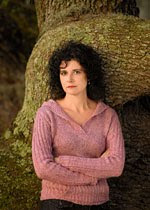Let's let Kathryn tell us the inspiration for her fiction herself. And if you'd like to see a trailer for her book, you can do that at the end of her post.
Happy reading!
Mary Anna
Fictional bad guys are better
By Kathryn Casey
When Singularity, my first mystery, came out, I noticed a couple of distinct reactions from family and friends. Before reading it, they seemed delighted that I wasn’t hanging around courtrooms and prisons as much as in the past, during my more than two decades as a journalist, writing true crime books and covering real murder cases. “It’s good for you to not see such a depressing side of life,” my aunt said one day, patting my hand. “It’ll give you a more optimistic view of the world.”
I didn’t argue. First, my parents raised me to not contradict my elders. Second, it can get pretty intense covering real murder cases, sitting with the victims’ and defendants’ families, watching their reactions, listening to the evidence, often grisly, looking at disturbing crime scene photos, and then, later, interviewing the killers.
My family and friends relief, however, was short lived. When they’d actually read the book, some eyed me rather warily. “You know, Kathy,” a friend said over lunch in a crowded restaurant one afternoon. We were out celebrating the new novel, and we’d both sipped a couple glasses of champagne. I was feeling rather effervescent when she said, “Some of the girls have been talking, and we’re wondering if we should be concerned with the ideas you have floating around in your mind.”
I put down my fork, looked at her eye-to-eye, thought briefly, and then said, “You know, you really shouldn’t bother. I’m pretty sure, I’m okay.”
“But those murder scenes in your book,” she said, growing ever more adamant. “They were, how should I put this, unusual. Do you often think about such things often?”
Again, I took my time, considering the scenes she’d referred to. My main character, Sarah Armstrong, is a Texas Ranger/profiler. She doesn’t get the run of the mill murders. Instead, she’s kind of like that TV doc House, the one they call on to weed through all the clues when they can’t crack a case. In that first book, the one my friends had just read, Sarah hunted a serial killer and the death scenes were indeed unusual, in fact, ritualistic might have been a better word.
“You know, I do think about such things,” I told my friend, who shook her head slightly at my confession. “But you don’t need to worry, because the beauty of fiction is that none of it’s real.”
As my aunt had hoped, the transition from fact to fiction has been invigorating. After all those years covering real cases, I do have rather strange things floating around in my head, and, for the first time, I’m letting them out to play, resulting in plenty of plots and characters to draw on.
For instance, in the second book in the series, Blood Lines
So is it any surprise that in the aftermath of Hurricane Ike hitting my hometown, Houston, I wrote a book entitled The Killing Storm
Yet everything else materialized when I let my imagination take over, freed from worrying about sticking to the facts, able to mold the best plot, scene, and characters. What’s the most delightful thing about writing mysteries? For me, it’s that when it comes to the killer: pure fiction.
Kathryn Casey is the author of six highly acclaimed true crime books and the creator of the Sarah Armstrong mystery series. Learn more about her at www.kathryncasey.com















No comments:
Post a Comment